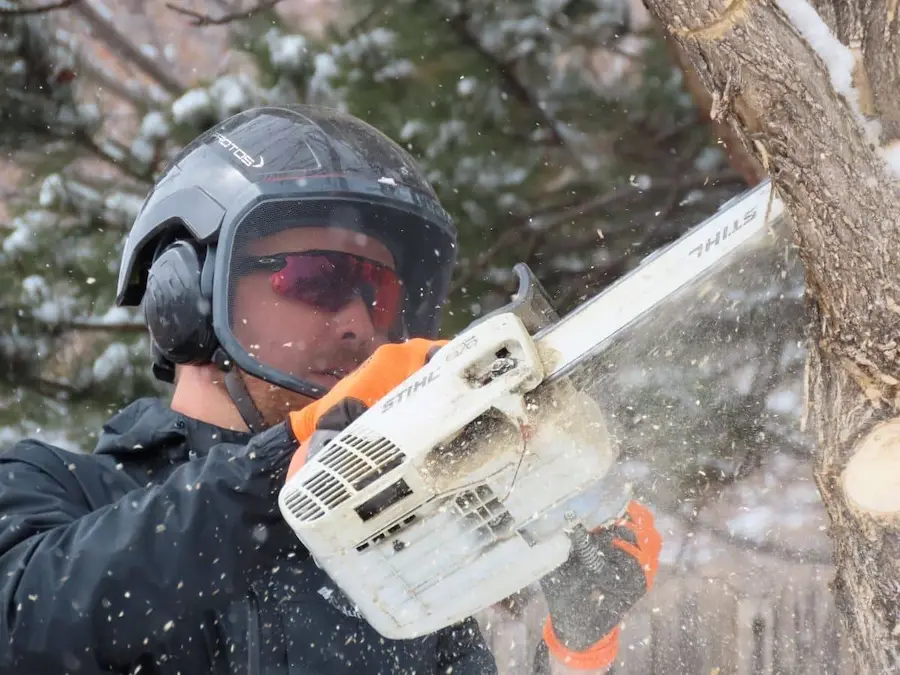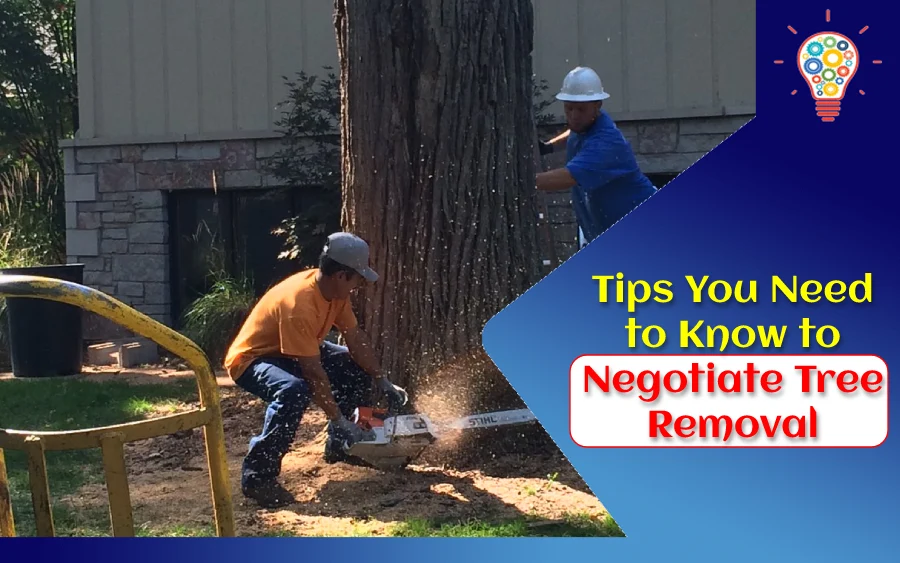There it is again. That pesky tree in your front yard screaming for attention. You’ve tried to avoid the issue, but it’s time to face the cold hard facts. The tree is leaning dangerously over the fence, and the roots are overtaking the sidewalk. It’s time to call in a professional and remove that tree.
Keep reading to learn tips from Negotiation Experts that will help you tackle the process with confidence and avoid draining your bank account for a pesky piece of wood.
Table of Contents
Do your homework
An informed customer is a powerful customer. When you know what you’re talking about, you can better negotiate for the services you require. So, before you pick up the phone, do your homework.
Here are a few things to educate yourself on:
- The average cost of tree removal in your area. This will give you a fair idea of the market rate and help you determine whether the company is charging you a reasonable price.
- The type of tree you have and the difficulty of removal. Knowing the type of tree can help you understand how long the removal process should take. For example, pine trees are easier to remove than oak trees.
- What removal equipment may be required? The type of equipment needed can affect the cost of the project.
- The duration of the job. As the saying goes, time is money. A longer job results in a higher bill.
- Any city ordinances that you may need to apply for to carry out the removal. You don’t want to be surprised by additional costs, so it’s best to be prepared ahead of time. Some cities, for example, require a permit for tree removal.
- Your homeowner’s insurance policy. In some cases, your insurance may cover the cost of tree removal.
Check if you qualify for free tree removal
In some cases, you may not have to pay for tree removal at all. For instance, if the tree is:
- Dead. Many cities offer free tree removal.
- Diseased. To prevent the spread of disease, some cities will remove affected trees at no cost to the landowners.
- Leaning on a power line. If the tree is dangerously close to or already leaning on a power line, the utility company may provide free removal.
- If a tree planted by the city is dangerously obstructing your property, you may be able to have it removed for free.
Each city has its own set of rules and regulations. So, be sure to check with your local government to see if you are eligible for free tree removal.
Shop around
After you’ve completed your research, the next step is to make a list of tree removal companies that could do the job. You could:
- Ask family, friends, or neighbors. Whenever possible, try to get referrals from people who have had work done recently. That way, you can get a current account of what it was like to work with the company and see their work.
- Search online directories such as Google or Yelp. Read customer reviews to get a sense of the company’s work quality and customer service. Also, cross-check companies you find with the Better Business Bureau website to ensure they are legitimate.
- If you live in a community with a homeowner’s association, check to see if they have a list of qualified tree removal companies.
Get multiple quotes
When you’ve narrowed down your options, reach out and request quotes. Keep the following in mind:
- Get no more than three quotes. Any more than that, you risk becoming overwhelmed and experiencing decision fatigue.
- Be sure to ask if the quote is for the total cost of the project or if any additional fees aren’t included in the estimate.
- Find out if the company offers discounts, for instance, in the case of multiple trees or for senior citizens.
- Get the quotes in writing. This is an important step that can help avoid any future misunderstandings.
- If one company’s quote is significantly lower than the others, be sure to ask why.
- Verify that the company has insurance. This is important in case something goes wrong during the job.

Consider doing some of the work yourself
You could offer to do some of the smaller tasks yourself. In return, the company may be willing to negotiate a lower fee for their services because it saves them both time and money. You could offer to:
- Prepare the site for tree removal.
- Remove green waste. For instance, you could take care of the smaller branches and leaves yourself.
- Save the bigger logs for firewood so the company won’t have to deal with them.
Of course, this is not an option for everyone. It’s important to make sure you have the time and energy to do the job safely.
Use smaller local companies
Often, small local companies have more flexible pricing than larger companies. As a result, they may be more willing to negotiate a lower price with you. They may also have more leeway to include extras to sweeten the deal.
Working with local companies could also be an advantage as they tend to be more invested in their community and customer relationships. Here are a few tips for negotiating with small local companies:
- Get personal. Mention if you know the owner or manager of the company. This may make them more open to working with you.
- Be flexible. Let them know if you can be flexible with your schedule. This may allow you to work around their other appointments and get a lower rate.
Schedule the work off-season
Most businesses have an on and off-season. The tree removal industry is no exception. Getting a great deal during the on-season, when demand is at its highest and prices at their peak, can be tough. However, if you’re willing to schedule the work during the off-season, you could save yourself some money.
If you can schedule the work during the off-season, keep the following in mind:
- Confirm the company is still in operation. You don’t want to be left in the lurch if they close for the season halfway through the job.
- Be prepared for the job to take longer than usual. Since demand is lower, some companies may have fewer staff working on your project so may need a little while longer to complete it.
Consider paying in cash
Businesses often incur fees when they process credit card payments. So, consider paying in cash to reduce the tax fees of the company. It may provide you with more negotiating power. If you’re unable to pay the entire amount in cash, you could offer a partial payment.
If you choose to pay in cash:
- Be sure to get a receipt. This can be a handwritten receipt. This will come in handy if there’s ever a payment dispute.
- Don’t pay the entire amount upfront. Pay a deposit of 10-20% to secure the job, then make the final payment upon completion.
- Get the terms of the agreement in writing.
Control your emotions
If you want to be a successful negotiator, learn to control your emotions. Remember that the goal is to get the best possible price for the job, not to frustrate or upset your contacts at the company. So, keep your cool and focus on your goal. Losing your cool or becoming emotional will only make it more difficult to negotiate what you want.
Here are some helpful tips for keeping your emotions in check:
- Focus on the facts rather than your emotional state.
- If you start to feel emotional, take a break from the conversation.
- Don’t take things personally. Negotiating isn’t personal. Most businesses are not out to take advantage of you. Most simply want to make a profit so that it’s worth their while.
- Be ready to walk away. If you’re not getting the price you want, be prepared to walk away from the negotiation. This will show that you’re serious about getting a fair price.
Avoid negotiating from a position of desperation
If you are pushed for time, the company will sense your desperation and may take advantage of it. So, avoid negotiating from a position of desperation.
One way to prevent this is to address the problem before it becomes a crisis. If there’s a tree that’s started to lean, for example, get an estimate for removal before it becomes an emergency. Waiting until a tree is about to topple over and crush your car or house can make you desperate.
Bundle multiple jobs together
Many tree removal companies also provide other services, like lawn care, stump removal, and tree trimming. Bundling multiple jobs together could get you a better deal. So, before you engage in any negotiations, check to see if you need any additional work done. Then use that information to negotiate a better deal.
Ask around your friends or neighbors, in case they have some pending tree work that needs doing. You could also double-check with your homeowner’s association or local businesses. If they are also in need of tree removal services, you could band together and negotiate a group rate.
Get everything in writing
Negotiation can be tiring. Once you’ve got all the details sorted, it’s tempting to give the job the green light and move on. Negotiation experts, however, say there is one more critical step: get everything in writing.
Handshake agreements, while seemingly honorable, don’t protect your interests. They also don’t hold up in court. So, you need to ensure there’s a paper trail. A written contract can also help to avoid any misunderstandings later down the road.
Once you’ve received an agreement:
- Don’t sign on the dotted line immediately. Run through the agreement with a fine-toothed comb. Check it contains everything you agreed to. In particular, take note of the total price, scope of work, and completion date.
- If you’ve agreed to do any of the work yourself, make sure it’s included in the agreement.
- Keep an eye out for any red flags. For example, be on the lookout for language that releases the company from liability. Keep your eyes peeled for any clauses allowing the company to change the price or scope of work without your consent. If you notice anything that makes you uncomfortable, bring it up with the company before you sign the agreement.
- If any details are missing, ask for them to be added to the agreement before work begins.
- Keep a copy for your records even after the removal company completes the work. You might need to refer to it at some point.
Final thoughts
By following the tips above, you can enter negotiations from a position of strength. Before you know it, that pesky tree will be out of your hair without you needing to dry out your bank account.
Read also: How Much Does Tree Lopping Or Pruning Cost?

